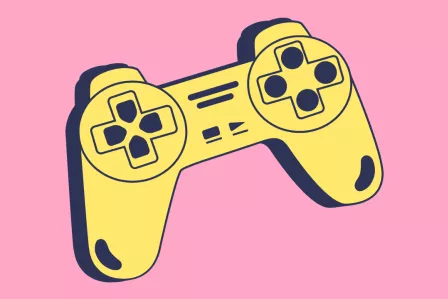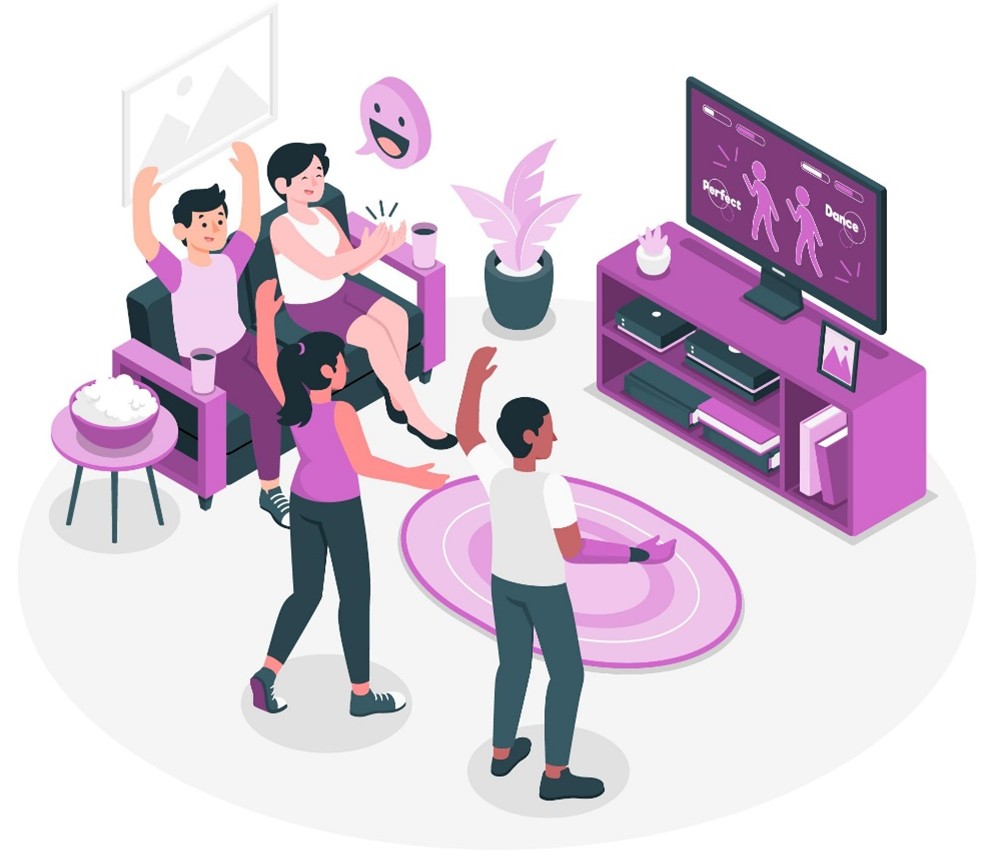
Videogames and online gaming are a regular leisure activity for many people. 53 per cent of European citizens aged between 6 and 64 play video games, with only 25 per cent of video game players aged under 18 years of age. There is a fairly equal gender split in young gamers, with girls making up 43,5 per cent of European gameplayers.

This deep dive will explore the risks that your child may face when gaming online and what you can do to support them to manage those risks.
Why do children and young people enjoy gaming?
Before diving into the risks that can be faced when gaming, it is important to recognise that playing video games can also provide many benefits to children and young people.
These include:
- Enhancing cognitive skills: Video games can improve problem-solving, spatial awareness, attention to detail, and decision-making.
- Developing social skills: Multiplayer video games allow young people to collaborate and develop teamwork, leadership and communication skills.
- Improving mental health: Video games can provide an outlet for stress and anxiety, as well as improve mood and self-esteem.
- Encouraging creativity: Some video games offer players the ability to be creative, expressive and innovative.
- Providing educational value: Some video games can teach skills such as critical thinking, problem-solving, history, geography, and even foreign languages.
What are the potential risks?
Not all games carry the same risks. The age and experience of your child can also affect the risks they face in online games.
Each of the following sections will focus on one of the 4Cs of risk; contact, content, conduct and contract. For general information about the 4Cs of online risk, please see the ‘What are the risks my child might face online?’ module.
Risks related to Contact
These risks involve contact with other users. These could be from people your child knows, or from strangers. Many interactions are positive, but it is always the negative interactions that carry risk of harm.
- Contact with strangers – many online games seek to match or group players together, particular in PvP (player versus player) games where players are in teams. This can lead your child to communicate with strangers in a game, even if they haven’t tried to find strangers to talk to. In many cases, this communication may be positive, when chat is focused on the game task and is friendly and supportive. An important aspect of online communication for children to learn is that you can be friendly online, but you don’t have to be everyone’s friend.
- Cyberbullying – this can take many different forms in online games such name-calling, harassment, and exclusion from a group. It can occur through in-game chat messages, voice chat with other players, or through abusive behaviours in a game, such as constantly targeting and killing the same player to upset them. Want to know more about cyberbullying? Check out this deep dive module.
- Inappropriate contact – Other players may try to start inappropriate or sexual conversations, or ask for sexual images or sensitive personal information.
- Grooming - Online predators may use gaming platforms to build trust with children, and then use that trust to exploit and harm them. Make your child aware that anyone who tries to move their conversation from the public chat to private chat might be doing it in order to manipulate and exploit them.
- Online scams - Some players may offer fake prizes or giveaways to try to steal personal information or money. Remind your child never to give sensitive information to other players, such as their home address, phone number or passwords.

Risks related to Content
According to PEGI (Pan European Gaming Information), only 12 per cent of games rated in 2021 were rated 18 (for adults only). There are many games suitable for children of all ages (37 per cent is rated PEGI 3 or 7).
This content could include:
- Violence - Many games with higher age ratings feature violent content that may be inappropriate or upsetting for children. Experts disagree on whether violent videogames can make children more aggressive, but all agree that seeing violent content in a game can be upsetting for some children.
- Sexual content – Games rated PEGI-18 may contain explicit sexual content or nudity that is not suitable for younger players.
- Profanity - Some games may contain profanity or swearing that may cause offence.
- Drugs and alcohol – Games aimed at adults may depict the use of drugs and alcohol, which may not be appropriate for younger players.
- Gambling - Some games may contain gambling elements, which can be potentially addictive and may encourage real-world spending.
- Advertising – ‘Free to play’ mobile games rely on displaying adverts to make money. There are rare cases of in-game advertising display products or themes that are not suitable for children (such as gambling or adult dating services).
In addition, games that offer user-generated content to be uploaded and played by other users (such as Roblox, Minecraft and Fortnite) can also lead to children seeing content or themes that are not age-appropriate. While most platforms have rules and tools in place to moderate this content, these are never 100% effective.
Activity
Below are the content descriptor icons used by PEGI. They give an ‘at a glance’ view of what types of content a game contains, to help you and your family make informed choices on what is suitable to play.
It's quiz time!
For this activity, the labels have been deliberately mixed up. Can you correctly match the content descriptor to the icon?
 | Drugs |
 | Discrimination |
 | Bad language |
 | Sex |
 | Fear |
 | Violence |
 | Gamlbing |
 | In-game purchases |
Risks related to Conduct
While many risks involve other players in online games, it is important to remind your child of the responsibility they have to behave appropriately and play fairly when gaming. Poor conduct can lead to being banned from online games, and possibly having their account deleted by the game provider.
These conduct risks can include:
- Harassment or bullying - Young people may be harassed, bullied or targeted with hate speech by other players in online games but they may also use online games as a space to bully or harass other players. Games are about playing as a character or avatar, and this can make it easier to hide your identity in order to mistreat others.
- Cheating - Some players cheat or hack in games to get an unfair advantage, ruining the fun for other gamers. If found out, they run the risk of being permanently banned from the game and losing their account, along with any items, currency or achievements.
- Sharing personal information – ‘Doxing’ is a form of bullying where someone discloses sensitive personal details about another person. This behaviour can occur in games as a form of revenge and lead to someone being bullied or harassed, both online and offline.
- Inappropriate behaviour - Some online games have a reputation for being places where offensive language and insults are commonplace. For some gamers, this is considered to be ‘banter’ that can disrupt the concentration of their opponents, but for many people it is simply considered inappropriate behaviour that ruins the experience.
- Reputational damage – For some gamers, their in-game persona is their main online identity. As with other online identities, they may have built up a reputation or following. Negative actions or behaviour could damage this reputation, impacting on their enjoyment and success in a game.
Risks related to Contract
This final area of risks is related to the commercial aspects of online gaming that may impact on the safety, well-being and financial security of your child.
Risks in this area include:
- In-game purchases - Many online games offer the ability to buy content using real money. Children may be tempted to spend money on virtual items such as skins, weapons or power-ups, which can lead to excessive spending. If these purchases are made with your credit card (or other payment method) make sure to monitor and limit or prohibit spending in the parental support tools.
- Scams and frauds – Being tricked into buying fake items or giving away personal data to scammers can lead to financial loss, or identity theft if account details are given away.
- Unfair practices - Some games may include ‘pay-to-win’ features that give an unfair advantage to players who spend money on the game, creating a disadvantage for those who cannot or choose not to spend money. Gamers who spend large amounts of money to gain an advantage are known as ‘whales’.
- Gambling – Games that offer purchases of loot boxes are widely considered to be like gambling. These loot boxes offer a random chance to obtain skins (outfits, characters or patterns), power ups or other items that are purely for aesthetics or to offer an advantage in-game. But the chances of getting a rare item are very low.
- Addiction – Although cases are rare, online gaming addiction can lead to financial losses but also lead to physical and mental health issues. In 2018, the World Health Organisation classified ‘gaming disorder’ as a mental health condition.
- Persuasive design – Part of the reason why some players become addicted to online games or develop bad habits is down to the persuasive design techniques used to encourage players to spend longer (and sometimes more money) in the game. These are sometimes termed as ‘dark patterns’ and this site highlights mobile games that may contain these traits, as well as games which don’t!

How can I support my child to enjoy online games positively and safely?
There are many things you can do to support your child to enjoy online gaming safely:
- Get playing! – Sometimes the best way to be engaged in your child’s online gaming is to dive in and play a game alongside them – the Family Gaming Database is a great resource that encourages families to enjoy video games and board games together. Playing games together can help you understand why your child enjoys those experiences.
- Discuss online respect – Take the time to talk regularly to your child about their interactions with others in games. Discussing what it means to be respectful, a good team player and a gracious winner/loser are all important traits that apply to all games and sports, online and offline.
- Discuss strangers, trust and personal information – Also take opportunities to discuss with your child what trust online means to them – who can you trust, and how far? What personal information can you share in a game (hobbies/interests) and what should you not share (contact details, location, etc.)? What might a scammer want from you in an online game?
- Be mindful of emotions – As with other art forms, video games have to the potential to affect our mood. Look out for changes in behaviour in your child and always remind them that you are there to support them if they are worried about anything they experience in online games.
- Teach strategies for responding to risk – Helping your child know how to block/mute and report offensive users in different games is important, as is reminding them to always tell you or another trusted adult if they or another player are being subjected to bullying, harassment or hate speech.
- Explain age classifications – Help children to become familiar with the PEGI ratings and content descriptors so that you can work together to make informed choices about what they play. Always encourage them to play age-appropriate games where possible.
- Encourage a healthy balance – Help your child to consider ways to balance their gaming with other activities. Taking regular breaks and setting time limits/goals can help, as can creating a family agreement or plan about when they can game, and for how long.
- Set up parental controls - every video game platform offers a set of tools to monitor or limit certain functionality. Via an easy-to-use app, parents can get a good overview of their child’s account and and together they can set limits to screentime, spending of money, interaction with friends or other players, and the maximum PEGI age for video games. Seize the Controls has all the information about the practical aspects of parental tools.
Further information and resources
Want to learn more about supporting young people to game positively and safely? These resources may be useful:
Educational resources from across the Insafe network of Safer Internet Centres. You can search for ‘gaming’, for resources in your language and for resources for different age groups.
This resource for primary-aged children, teachers and parents/carers provides information and advice on a range of online issues, including contract and commercial issues that may be faced in games, such as loot boxes. There are accompanying activities that teachers can use in the classroom and parents can use at home.
The official website of PEGI provides more information about age classification alongside advice for parents/carers.
ISFE’s website contains advice for parents/carers on how to support children to game responsibly and safely.

Videogames and online gaming are a regular leisure activity for many people. 53 per cent of European citizens aged between 6 and 64 play video games, with only 25 per cent of video game players aged under 18 years of age. There is a fairly equal gender split in young gamers, with girls making up 43,5 per cent of European gameplayers.

This deep dive will explore the risks that your child may face when gaming online and what you can do to support them to manage those risks.
Why do children and young people enjoy gaming?
Before diving into the risks that can be faced when gaming, it is important to recognise that playing video games can also provide many benefits to children and young people.
These include:
- Enhancing cognitive skills: Video games can improve problem-solving, spatial awareness, attention to detail, and decision-making.
- Developing social skills: Multiplayer video games allow young people to collaborate and develop teamwork, leadership and communication skills.
- Improving mental health: Video games can provide an outlet for stress and anxiety, as well as improve mood and self-esteem.
- Encouraging creativity: Some video games offer players the ability to be creative, expressive and innovative.
- Providing educational value: Some video games can teach skills such as critical thinking, problem-solving, history, geography, and even foreign languages.
What are the potential risks?
Not all games carry the same risks. The age and experience of your child can also affect the risks they face in online games.
Each of the following sections will focus on one of the 4Cs of risk; contact, content, conduct and contract. For general information about the 4Cs of online risk, please see the ‘What are the risks my child might face online?’ module.
Risks related to Contact
These risks involve contact with other users. These could be from people your child knows, or from strangers. Many interactions are positive, but it is always the negative interactions that carry risk of harm.
- Contact with strangers – many online games seek to match or group players together, particular in PvP (player versus player) games where players are in teams. This can lead your child to communicate with strangers in a game, even if they haven’t tried to find strangers to talk to. In many cases, this communication may be positive, when chat is focused on the game task and is friendly and supportive. An important aspect of online communication for children to learn is that you can be friendly online, but you don’t have to be everyone’s friend.
- Cyberbullying – this can take many different forms in online games such name-calling, harassment, and exclusion from a group. It can occur through in-game chat messages, voice chat with other players, or through abusive behaviours in a game, such as constantly targeting and killing the same player to upset them. Want to know more about cyberbullying? Check out this deep dive module.
- Inappropriate contact – Other players may try to start inappropriate or sexual conversations, or ask for sexual images or sensitive personal information.
- Grooming - Online predators may use gaming platforms to build trust with children, and then use that trust to exploit and harm them. Make your child aware that anyone who tries to move their conversation from the public chat to private chat might be doing it in order to manipulate and exploit them.
- Online scams - Some players may offer fake prizes or giveaways to try to steal personal information or money. Remind your child never to give sensitive information to other players, such as their home address, phone number or passwords.

Risks related to Content
According to PEGI (Pan European Gaming Information), only 12 per cent of games rated in 2021 were rated 18 (for adults only). There are many games suitable for children of all ages (37 per cent is rated PEGI 3 or 7).
This content could include:
- Violence - Many games with higher age ratings feature violent content that may be inappropriate or upsetting for children. Experts disagree on whether violent videogames can make children more aggressive, but all agree that seeing violent content in a game can be upsetting for some children.
- Sexual content – Games rated PEGI-18 may contain explicit sexual content or nudity that is not suitable for younger players.
- Profanity - Some games may contain profanity or swearing that may cause offence.
- Drugs and alcohol – Games aimed at adults may depict the use of drugs and alcohol, which may not be appropriate for younger players.
- Gambling - Some games may contain gambling elements, which can be potentially addictive and may encourage real-world spending.
- Advertising – ‘Free to play’ mobile games rely on displaying adverts to make money. There are rare cases of in-game advertising display products or themes that are not suitable for children (such as gambling or adult dating services).
In addition, games that offer user-generated content to be uploaded and played by other users (such as Roblox, Minecraft and Fortnite) can also lead to children seeing content or themes that are not age-appropriate. While most platforms have rules and tools in place to moderate this content, these are never 100% effective.
Activity
Below are the content descriptor icons used by PEGI. They give an ‘at a glance’ view of what types of content a game contains, to help you and your family make informed choices on what is suitable to play.
It's quiz time!
For this activity, the labels have been deliberately mixed up. Can you correctly match the content descriptor to the icon?
 | Drugs |
 | Discrimination |
 | Bad language |
 | Sex |
 | Fear |
 | Violence |
 | Gamlbing |
 | In-game purchases |
Risks related to Conduct
While many risks involve other players in online games, it is important to remind your child of the responsibility they have to behave appropriately and play fairly when gaming. Poor conduct can lead to being banned from online games, and possibly having their account deleted by the game provider.
These conduct risks can include:
- Harassment or bullying - Young people may be harassed, bullied or targeted with hate speech by other players in online games but they may also use online games as a space to bully or harass other players. Games are about playing as a character or avatar, and this can make it easier to hide your identity in order to mistreat others.
- Cheating - Some players cheat or hack in games to get an unfair advantage, ruining the fun for other gamers. If found out, they run the risk of being permanently banned from the game and losing their account, along with any items, currency or achievements.
- Sharing personal information – ‘Doxing’ is a form of bullying where someone discloses sensitive personal details about another person. This behaviour can occur in games as a form of revenge and lead to someone being bullied or harassed, both online and offline.
- Inappropriate behaviour - Some online games have a reputation for being places where offensive language and insults are commonplace. For some gamers, this is considered to be ‘banter’ that can disrupt the concentration of their opponents, but for many people it is simply considered inappropriate behaviour that ruins the experience.
- Reputational damage – For some gamers, their in-game persona is their main online identity. As with other online identities, they may have built up a reputation or following. Negative actions or behaviour could damage this reputation, impacting on their enjoyment and success in a game.
Risks related to Contract
This final area of risks is related to the commercial aspects of online gaming that may impact on the safety, well-being and financial security of your child.
Risks in this area include:
- In-game purchases - Many online games offer the ability to buy content using real money. Children may be tempted to spend money on virtual items such as skins, weapons or power-ups, which can lead to excessive spending. If these purchases are made with your credit card (or other payment method) make sure to monitor and limit or prohibit spending in the parental support tools.
- Scams and frauds – Being tricked into buying fake items or giving away personal data to scammers can lead to financial loss, or identity theft if account details are given away.
- Unfair practices - Some games may include ‘pay-to-win’ features that give an unfair advantage to players who spend money on the game, creating a disadvantage for those who cannot or choose not to spend money. Gamers who spend large amounts of money to gain an advantage are known as ‘whales’.
- Gambling – Games that offer purchases of loot boxes are widely considered to be like gambling. These loot boxes offer a random chance to obtain skins (outfits, characters or patterns), power ups or other items that are purely for aesthetics or to offer an advantage in-game. But the chances of getting a rare item are very low.
- Addiction – Although cases are rare, online gaming addiction can lead to financial losses but also lead to physical and mental health issues. In 2018, the World Health Organisation classified ‘gaming disorder’ as a mental health condition.
- Persuasive design – Part of the reason why some players become addicted to online games or develop bad habits is down to the persuasive design techniques used to encourage players to spend longer (and sometimes more money) in the game. These are sometimes termed as ‘dark patterns’ and this site highlights mobile games that may contain these traits, as well as games which don’t!

How can I support my child to enjoy online games positively and safely?
There are many things you can do to support your child to enjoy online gaming safely:
- Get playing! – Sometimes the best way to be engaged in your child’s online gaming is to dive in and play a game alongside them – the Family Gaming Database is a great resource that encourages families to enjoy video games and board games together. Playing games together can help you understand why your child enjoys those experiences.
- Discuss online respect – Take the time to talk regularly to your child about their interactions with others in games. Discussing what it means to be respectful, a good team player and a gracious winner/loser are all important traits that apply to all games and sports, online and offline.
- Discuss strangers, trust and personal information – Also take opportunities to discuss with your child what trust online means to them – who can you trust, and how far? What personal information can you share in a game (hobbies/interests) and what should you not share (contact details, location, etc.)? What might a scammer want from you in an online game?
- Be mindful of emotions – As with other art forms, video games have to the potential to affect our mood. Look out for changes in behaviour in your child and always remind them that you are there to support them if they are worried about anything they experience in online games.
- Teach strategies for responding to risk – Helping your child know how to block/mute and report offensive users in different games is important, as is reminding them to always tell you or another trusted adult if they or another player are being subjected to bullying, harassment or hate speech.
- Explain age classifications – Help children to become familiar with the PEGI ratings and content descriptors so that you can work together to make informed choices about what they play. Always encourage them to play age-appropriate games where possible.
- Encourage a healthy balance – Help your child to consider ways to balance their gaming with other activities. Taking regular breaks and setting time limits/goals can help, as can creating a family agreement or plan about when they can game, and for how long.
- Set up parental controls - every video game platform offers a set of tools to monitor or limit certain functionality. Via an easy-to-use app, parents can get a good overview of their child’s account and and together they can set limits to screentime, spending of money, interaction with friends or other players, and the maximum PEGI age for video games. Seize the Controls has all the information about the practical aspects of parental tools.
Further information and resources
Want to learn more about supporting young people to game positively and safely? These resources may be useful:
Educational resources from across the Insafe network of Safer Internet Centres. You can search for ‘gaming’, for resources in your language and for resources for different age groups.
This resource for primary-aged children, teachers and parents/carers provides information and advice on a range of online issues, including contract and commercial issues that may be faced in games, such as loot boxes. There are accompanying activities that teachers can use in the classroom and parents can use at home.
The official website of PEGI provides more information about age classification alongside advice for parents/carers.
ISFE’s website contains advice for parents/carers on how to support children to game responsibly and safely.











